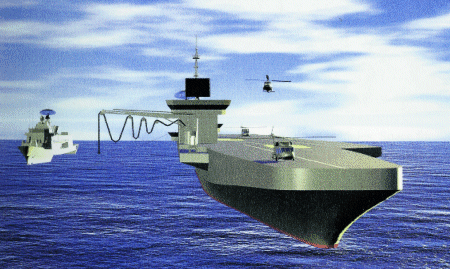Naval aviation force projection is in Australia's sights
Peter La Franchi/SYDNEY
On 24 June last year, the then director general of maritime development in the Australian Defence Headquarters Capability Development Unit, Commodore Tim Cox, wrote in a minute that the Royal Australian Navy's (RAN) possible reactions to the Royal Australian Air Force's (RAAF) new Project Air 6000 future fighter programme.
Air 6000, Cox noted, had the potential to seriously distort Australia's military acquisition priorities in favour of air power for most of a decade, with major follow-on consequences for the RAN's own force development.
Cox wrote that the future fighter was being pitched by the RAAF as an expeditionary capability, meaning that it would be the deployment option of choice for future Australian involvement in the wider Asia-Pacific region. The RAN, he wrote, should become directly involved in the RAAF's deployment equations through the development of what he termed 'mobile bare bases', a floating force projection system essentially modelled on the Pentagon's Joint Mobile Offshore Base concept.
The argument did not go unnoticed in other parts of the RAN. Around the same time, the Australian Naval Material Branch was exploring long-term options for replacing the RAN's fleet of amphibious and auxiliary replenishment ships, a mixed bag of five vessels in four different classes sourced from three different nations. RAN studies since 1997 suggested that a single type might be able to support the diverse range of roles, but based on different above-water configurations for specific roles.
Cox's notes provided the existing concept work with a critical new focus: fixed-wing air operations at sea. By late 1999, the RAN's Material Division was able to lock down the concept for the common multi-role vessel, designated the Littoral Support Ship (LSS).

The studies did not go unheeded in the Australian Defence Headquarters. Could the LSS concept, it asked, be adapted further, to focus instead on a rotary wing capability but to also be capable of operating amphibious craft through a stern flooding-dock? By early March this year, the RAN Material Requirements Branch design team had finalised the LSS study and the derivative option, a scaled-down design designated the Multi-Role Auxiliary (MRA).
Details of both concepts were released this month by the RAN at the Australian Department of Defence's biannual amphibious warfare conference in Sydney. As it stands, the LSS is a 29,000t hybrid carrier capable of operating up to 20 Boeing F/A-18-class fighter aircraft, but also able to carry a battalion of troops or operate as an underway replenishment ship.
The LSS would either be fitted with a steam catapult, adding 1,000t to the design, or a bow 'ski-jump' similar to the ramp system adopted by the old Soviet navy as a solution to getting aircraft designed for land bases to operate off carriers at sea. Returning aircraft would use arrested recovery, with RAAF F/A-18s already engineered to support short tail-hook systems. As an alternative to fighter aircraft, the ship would also be capable of carrying up to 20 helicopters in the Sea King class.
To meet offshore airborne early warning and control (AEW&C) requirements, the studies considered refurbishing Grumman S-2 Tracker aircraft, and converting new-build Bell Boeing MV-22 Osprey or Bell-Agusta 609 tiltrotors. The Northrop Grumman E-2C Hawkeye was rejected on the basis that it would be too heavy to operate from a small carrier.
The studies also considered using vertical take-off and landing unmanned air vehicles in the AEW&C role, with derivatives of the Bell Eagle Eye identified as potential candidates.
The MRA variant would displace some 20,000t with a cut-down flight deck capable of simultaneously operating six Sikorsky UH-60 Black Hawk-sized helicopters, or four Boeing CH-47D Chinook helicopters. However, the vessel retains the ability to carry aircraft such as the MV-22 Osprey, with design studies dated 20 February this year again emphasising the need for an organic AEW&C capability. Design work now underway is assessing the options for fitting the flooding-dock requirement.
The RAN regards the MRA, or a ship in its class, as the preferred way ahead for its amphibious fleet after 2015, when its two existing LPH transports, each able to carry and operate three UH-60s or two CH-47Ds, are to retire. The new ships would be the largest operated by the RAN since the retirement of the aircraft carrier HMAS Melbourne in the mid-1980s.
RAN strategy calls for the hybrid-carrier fleet to gain endorsement as part of the new Defence White Paper being prepared for the Australian Government. The new ships may prove to be an attractive option if that paper calls for stepped-up force projection capabilities within the Asia-Pacific region, particularly as Canberra is aware of aircraft carrier developments emerging in China and India. Interestingly, the RAN's aspirations are being strongly supported by the Australian Army as a result of lessons emerging from last year's intervention in East Timor and current patterns of destabilisation in the South Pacific.
However, with a total price tag of A$6-8billion (US$3.75-5billion), the project faces major hurdles in the stringent Australian defence funding environment, with this possibly including opposition from within the RAN itself.
Source: Flight International
















